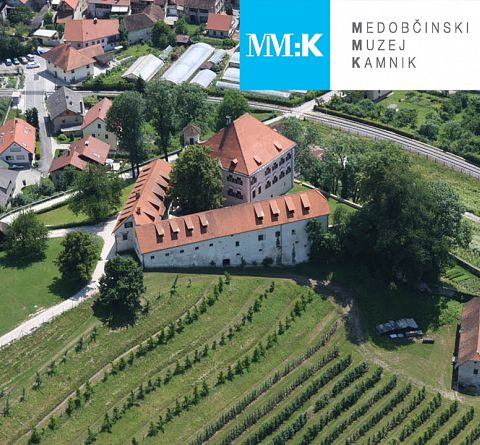Year 2020 at the Intermunicipal Museum Kamnik
We are expecting several interesting exhibitions for 2020 that are of national importance and will also be the result of cooperation with other museum institutions, societies and individuals.
In the museum at the Castle Zaprice we will remember 100th birth anniversary of academician prof. dr. Stane Gabrovec, an elder of Slovenian archaeology, an honorary citizen of the municipality of Kamnik. He was a classical philologist, archaeologist by education, but a great humanist and a top expert and scientist. He has worked in three fields – museum, university-pedagogical and scientific-research. In the Department of Archaeology, dozens of students have opted for a degree in metal (bronze or iron age) with prof. Gabrovec. He has left an indelible mark on them and on Slovenian archaeology and he is precisely all of his students who have become the leading force for the development of recent decades. In the 1960s and 1970s, he conducted major international excavations in Stična, as well as many other excavations, culminating in basic publications. Above all, he was a great humanist and a great man.
We will prepare an exhibition to showcase his works and personality. At the Gabrovec memorial evening, the importance and history of the tireless researcher will be broadly illuminated by his colleagues or students from institutions in which he has actively worked: from the Slovenian Academy of Sciences and Arts, the National Museum of Slovenia and the Department of Archeology, FF, University of Ljubljana.
We also continue to introduce interesting personalities, families – From family archives. Presentation of an interesting Rojc family from Volčji Potok, from a fighter in Bosnia in 1878 to a cowboy and actor in Hollywood and an artist to a generation of gardeners at Souvan Park in Volčji Potok.
Let us also point out the exhibition Slovenian majolica, which we are planning together with the National Museum of Slovenia and the Society Why Not Majolica. In May 2020, it will first be on display at the National Museum of Slovenia, from October 2020 in the Intermunicipal museum Kamnik at Zaprice Castle.
The main object of the exhibition Slovenian majolica will be majolica, a special shape of the wine handle, which was named after the majolica ceramic technique, which is named after the Spanish island of Majorca. The technique of making these vessels was perfected in Italy in the 15th and 16th centuries, which is the origin of this type of , but the majolica in Slovenia began to be made only in the first decades of the 19th century. This wine with a spherical belly and a three-leaf mouth with a funnel has a special status in Slovenian art. Majolica has become, so to speak, a mythological object, closely linked to the identity of the Slovenian nation. Even as a symbol of good and happy society, it is sung by folk songs and is the subject of still life.
In Slovenia, the most famous ones are those made by the Svit Kamnik ceramic factory from the beginning of the 1950s until the end of its existence in 2008, and before that, of course, the Schnabl Ceramic Workshop. Equipped with city coats of arms, floral arrangements or waxes for important life anniversaries and milestones, they were a popular gift and home decor.
At the Rudolf Maister’s Birthplace, we will commemorate the 100th anniversary of the plebiscite in Carinthia with the exhibition Carinthian Plebiscite 1920 in literature and music. We decided to explore and present this period primarily from a literary and musical point of view. In addition to Maister, whose work will be briefly presented along with a general introductory section on the events of the pre-plebiscite period, there will be six prominent protagonists who worked during and after the plebiscite: musicians Lovro Horvat and Pavle Kernjak, as well as four literary writers: Izidor Cankar, Prežihov Voranc, Ksaver Meško and Angela Piskernik.
An important part of the exhibition will be the theatre play Plebiscit, staged only on September 8, 1920 in Loga vas near Klagenfurt. We will also record this performance and it will rotate on the show on an interactive whiteboard that will be presented as a stage. From a literary and musical point of view, this topic has not been explored so far, so this exhibition will certainly bring new discoveries and a fresh image. The exhibition will also be hosted in St. Ilj in Carinthia and the Slovene Gymnasium in Klagenfurt.
The Gallery Miha Maleš celebrates its 40th birthday in 2020. During this year, we will be presenting nine exhibitions by artists that have marked different periods. The main gallery space, which also houses the permanent collection of painter, graphic artist and publicist, Miha Maleš, will feature an exhibition of outstanding graphic artist Ivo Mršnik. It will be followed by an exhibition by the painter Klementina Golija, created in collaboration with the Gorenjska Museum and the Museums and Galleries of the Radovljica Municipality. In the autumn term, the exhibition of the Josip Germ will be on display in the central exhibition area. With it we will reach the time of academic realism on Slovenian soil. This exhibition is also the result of many years of cooperation between the Dolenjska Museum from Novo mesto and Kamnik.
Contemporary art has for many years been looked after by the Gallery View, which operates within the Gallery Miha Maleš on the second floor. The year will begin with painter Agata Pavlovec, followed by illustrator Polona Lovšin in the first half, and younger generation sculptor and visual artist Katja Bogataj. The summer will be marked by the famous Slovenian painter Žarko Vrezec with a very intimate project, which is created just for the Gallery View, since the author is known to us for his larger formats. In the second half of the year the painter Jernej Jemec will be presented, filling his canvases with the motifs of the forest, and the year will end with sculptural works from the series Keepers of the Secrets by Urša Toman.



